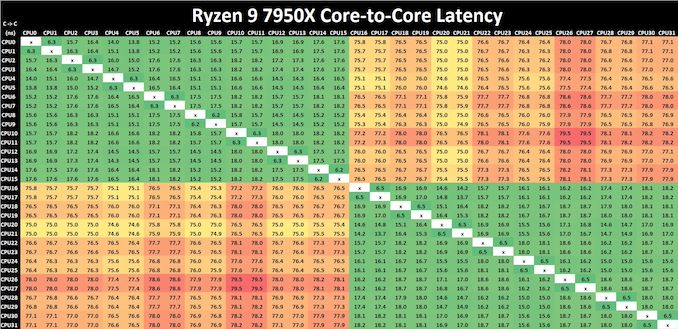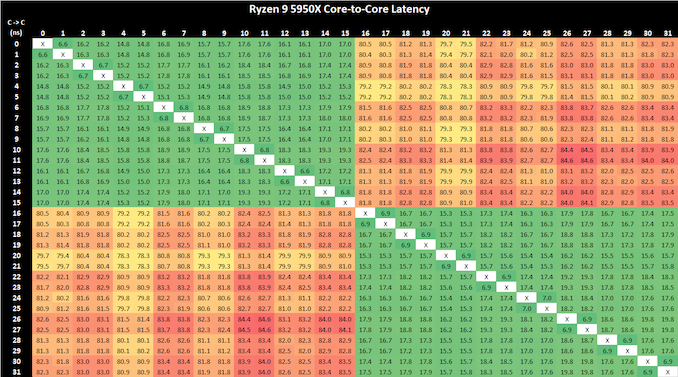AMD Zen 4 Ryzen 9 7950X and Ryzen 5 7600X Review: Retaking The High-End
by Ryan Smith & Gavin Bonshor on September 26, 2022 9:00 AM ESTCore-to-Core Latency
As the core count of modern CPUs is growing, we are reaching a time when the time to access each core from a different core is no longer a constant. Even before the advent of heterogeneous SoC designs, processors built on large rings or meshes can have different latencies to access the nearest core compared to the furthest core. This rings true especially in multi-socket server environments.
But modern CPUs, even desktop and consumer CPUs, can have variable access latency to get to another core. For example, in the first generation Threadripper CPUs, we had four chips on the package, each with 8 threads, and each with a different core-to-core latency depending on if it was on-die or off-die. This gets more complex with products like Lakefield, which has two different communication buses depending on which core is talking to which.
If you are a regular reader of AnandTech’s CPU reviews, you will recognize our Core-to-Core latency test. It’s a great way to show exactly how groups of cores are laid out on the silicon. This is a custom in-house test, and we know there are competing tests out there, but we feel ours is the most accurate to how quick an access between two cores can happen.

Click to enlarge (lots of cores and threads = lots of core pairings)
Comparing core to core latencies from Zen 4 (7950X) and Zen 3 (5950X), both are using a two CCX 8-core chiplet design, which is a marked improvement over the four CCX 16-core design featured on the Zen 2 microarchitecture, the Ryzen 9 3950X. The inter-core latencies within the L3 cache range from between 15 ns and 19 ns. The inter-core latencies between different cores within different parts of the CCD show a larger latency penalty of up to 79.5 ns, which is something AMD should work on going forward, but it's an overall improvement in cross CCX latencies compared to Zen 3. Any gain is still a gain.
Even though AMD has opted for a newer and more 'efficient' IOD which is based on TSMC's 6 nm node. It is around the same size physically as the previous AMD IOD on Zen 3 manufactured on GlobalFoundries 12 nm node, but with a much larger transistor count. Within the IOD is the newly integrated RDNA 2 graphics, although this isn't typical iGPU in the sense that an APU is. A lot of the room on the IOD is made up of the DDR5 memory controller or IMC, as well as the chips PCIe 5.0 lanes, and of course, connects to the logic through its primary interconnect named Infinity Fabric. All of these variables play a part on power, latency, and operation.

AMD Ryzen 9 5950X Core-to-Core Latency results
It's actually astounding how similar the latency performance of the Ryzen 9 7950X (Zen 4) is when compared directly to the Ryzen 9 5950X (Zen 3), despite being on the new 5 nm TSMC manufacturing process. Even with a change of IOD, but with the same interconnect, the inter-core latencies within the Ryzen 9 7950X are great in terms of cores within the same core complex; latency does degrade when pairing up with a core in another chiplet, but this works and AMD's Ryzen 5000 series proved that the overall penalty performance is negatable.










205 Comments
View All Comments
TheinsanegamerN - Tuesday, September 27, 2022 - link
Because MS is far less trustworthy then intel, and has been making moves to block, censor, and lock down everything whenever possible via hardware. Pluton should scare people, giving MS the keys to your hardware is a nightmare. ReplyIketh - Thursday, October 6, 2022 - link
please keep your irrational paranoia to yourself ReplyTheinsanegamerN - Tuesday, September 27, 2022 - link
He did say current, not future. ReplyAndrewJacksonZA - Monday, September 26, 2022 - link
Hi. What happened to RDR2 at 4K, please? ReplyRyan Smith - Monday, September 26, 2022 - link
RDR2 did not behave itself properly at 4K on some of our test systems. We're still trying to isolate why. ReplyAndrewJacksonZA - Monday, September 26, 2022 - link
Thanks Ryan. I'm really interested in that and GTA V at 4K. Thank you! :-) Replypiskov - Monday, September 26, 2022 - link
Please add current Apple CPUs if tests allow it. ReplyGhwomb - Tuesday, September 27, 2022 - link
Yes. That would be nice. Especially since Linux and openBSD support is coming along nicely on M1 and M2. Making it a viable option for non-macOS users. Replyddhelmet - Monday, September 26, 2022 - link
No Dolphin benchmark? ReplyHarry_Wild - Monday, September 26, 2022 - link
Buying Zen 4 7600X and motherboard, DDR5, MvME on Black Friday and/or CyberMonday! Might be $1K! Use my current graphics card, PSU and SFF case. Still a lot of dough! Reply